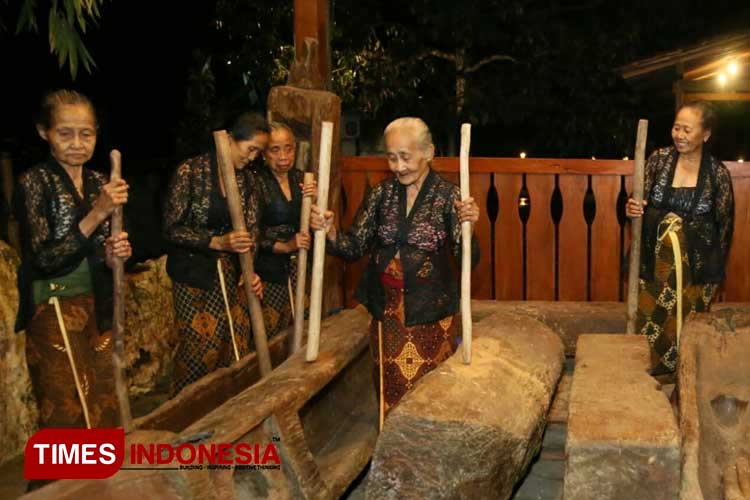Shaping Harmony: The Othek Symphony in Kemiren Cultural Village

TIMESINDONESIA, BANYUWANGI – Venturing into the heart of Banyuwangi, Indonesia, we discover the captivating tradition of Othek. It is an enchanting musical narrative spun from the rhythmic collaboration between the alu (pestle) and lesung padi (rice mortar) within the Osing community at Kemiren Cultural Village.
This cultural jewel is not only a testament to age-old customs but a living testament to the resilience and creativity of the grandmothers, aged 70 to 90, who breathe life into this unique art form.
Advertisement
As the harvest season unfolds, a majestic tree in the heart of the village becomes a gathering point for these spirited grannies. Here, beneath its expansive shade, they form a circle, each face adorned with a distinctive smile, as they prepare to embark on the melodic journey of Othek.
While their bodies may carry the marks of time, their agile fingers deftly bring forth the harmonious "thok thek thok thek," a rhythmic composition produced by the convergence of the alu and lesung padi. And that's where the name of the culture derived from.
Far beyond the mere act of rice pounding, Othek transforms into a lively performance, a tradition intricately woven into the fabric of their communal history. With sturdy wooden pestles in hand, these grandmothers choreograph a lively dance as they take turns pounding the rice, accompanied by joyous songs that resonate across the vast rice fields.
In their collective singing and laughter, they create a symphony that paints a vivid picture of togetherness and exuberance. Bounding joy and laughter around the community.
In a cultural context where the elder generation is often associated with solemnity during traditional practices. But it's not the same with those grandmothers of the Osing community, they become rejuvenated dancers, infusing the atmosphere with youthful exuberance.
As the rice is meticulously pounded, the village echoes with not just the sound of hard work but with laughter and melodies that echo the joy inherent in their shared heritage.
Originating as a symbolic expression of gratitude for abundant harvests, Othek has undergone a metamorphosis over time. In Kemiren Cultural Village, it has evolved into a performing art that transcends its utilitarian origins, captivating both locals and visitors alike.
The once-utilitarian rice mortar, now wielded as a musical instrument by the younger generation and local artists, takes center stage every evening, weaving an artistic tapestry that binds past and present.
Othek has seamlessly integrated into the warm embrace of Kemiren Cultural Village's hospitality, becoming an intrinsic part of the welcome extended to guests. The stage, set in the heart of the village, witnesses the nightly performance of Othek, not just as a display of artistry but as a source of communal pride and cultural legacy.
You could also find it at Sanggar Genjah Arum or Genjah Arum Gallery. This place was once a cafe but now become a place where those local cultural lovers gathered. Occasionally, the local will practice to play Othek at this cafe.
"It's beautiful, though it's only using gigantic pestle and mortar but the it makes a nice sound to my ear," Claudia, a local community said when she visited Kemiren Cultural Village (16/1/2023).
In this alternative perspective, Othek of Kemiren Cultural Village emerges not merely as a traditional routine but as a living symphony, composed by the hands of resilient grandmothers and played for the world to witness, a celebration of cultural resilience and artistic transformation. (*)
**) Ikuti berita terbaru TIMES Indonesia di Google News klik link ini dan jangan lupa di follow.
| Editor | : Khodijah Siti |
| Publisher | : Ahmad Rizki Mubarok |

